-
Ziyad Doueri: THE ATTACK (2012)-Centerpiece Film
Ziyad Douari: THE ATTACK (2012)
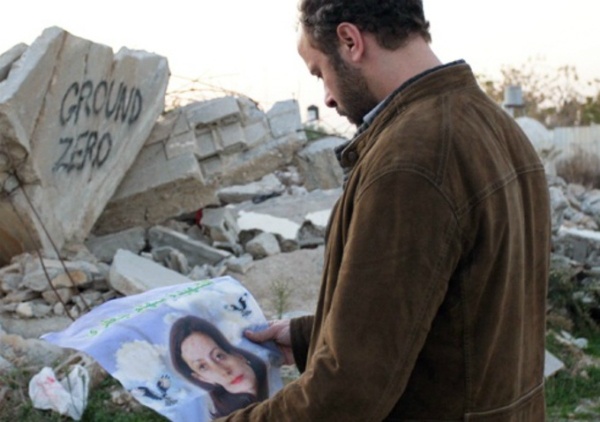
ALI SULIMAN IN THE ATTACK
Irreconcilable differences
Ziyad Doueri's The Attack provides an obvious setup. When Amin Jaafari, a distinguished Palestinian surgeon in Tel Aviv, gets a major Israeli award, there is a terrorist bombing and his wife, killed in the incident, becomes the prime suspect. This is a complete shock to him.
We get the point: even a thoroughly assimilated Palestinian awarded a national honor by Israeli society still finds his security and sense of belonging hang by a thread. The doctor, after treating the injured, is himself a suspect and is held for brutal interrogation but later found innocent and released. His colleagues at the hospital nonetheless pass around a petition to strip him of his Israeli citizenship. But a few Israeli colleagues remain utterly loyal. Incredulous and now angry at his wife whom he seems no longer to know or understand, Dr. Jaafari goes to Nablus to investigate, at considerable personal risk, the sources of the bombing, starting with his own and his wife's family.
This is a setup to show Palestinian rage and the impossibility of a Palestinian's assimilating into Israeli society. But it's not a very obvious setup, after all, because this can't be a very typical case. Surely Palestinians who've won distinction in Tel Aviv don't turn out to have wives who are suicide bombers -- or do they? The point, anyhow, seems indisputable: that no amount of success in Israel can shield a Palestinian from the suffering and anger of his people or their violent manifestations. And if Doueri stretches his plotline to make this point, maybe he is entitled to do so -- at least given the fact that the atmosphere and language feel authentic, particularly during the scenes set in Palestinian towns. The film is adapted from a novel by Yasmina Khadra. In his review of the film Peter Debruge of Variety says it "strips the source of nearly all its profundity."
The film turns into a kind of police procedural, but one where the investigator is not a cop but a collateral victim. There are no big revelations. In fact The Attack presents a situation more than it tells a story. This is both its weakness and its strength. Like Antonioni's L'Avventura, about a disappeared person who is hunted for in vain, leading to a puzzlement so rich it was deemed "a new cinematic language," The Attack mostly just points to dead ends. But the desired effect is to leave the audience in a state of profound discomfort. Insofar as it achieves this The Attack is a success.
Ali Suliman, who plays the lead role of Doctor Jaafari, is qualified by his background, an actor of Palestinian origin bilingual in Hebrew and Arabic and educated in Tel Aviv, and he gives a committed performance. His previous credits include Paradise Now, The Kingdom and Lemon Tree. And he's busy: he has had seven credits since The Attack. Doueri is a Lebanese who has worked more than once as a cameraman for Quentin Tarantino. His directorial debut was with the (1998) Beirut West, a lively, vernacular account of growing up during the Lebanese civil war of 1975. His second feature was less successful, an adaptation of Lila Says, a sexy French novel set in Marseilles. The Attack works well enough in bringing out the basics of its difficult subject matter, but Doueri's transition to seriousness and political relevance isn't totally successful. Though this effort is relevant and well-intentioned, without the director's previous humor and sexiness, without much individual style, his filmmaking becomes a little bit stiff and generic, and Debruge thinks the filmt feels "overlong and undernourished." But Manohla Dargis of the NY Times has the opposite view, seeing this film as superior to its source book: "In contrast to the novel, which habitually slips into polemicism and is bookended by a shock that dilutes its punch, Mr. Doueiri creates characters, emotional colors and political contradictions that have the agonized sting and breathe of life." In any case, the film has the solid polemical value, for some a provocation, of taking a neutral stance neither pro nor con Israel, yet acknowledging the inevitability of Palestinian rage.
If viewers don't get the message that that rage is just around the corner even in a high ranking Palestinian surgeon's house, that's part of an ongoing problem. But it is certainly a serious misinterpretation to say as one reviewer, Mike D'Angelo of AV Club, does, that this film "skirts perilously close to being an apologia for suicide bombing," though his being able to say this may be a sign of how the film has lost its source novel's complexity. Anyhow, the film's value is precisely that it is not an apologia for anything. The film works insofar as it unfolds from the developing point of view of Dr. Jaafari -- his understanding changing as he reviews memories we see as flashbacks. He never really understands or sympathizes with suicide bombings. To learn that it's not so hard for a Palestinian to become a suicide bomber is not the same as advocating one's doing so. Dr. Jaafari realies he's powerless when he finds pictures of his wife, whose action he despises, spread all over the Palestinian territories celebrating her as a patriotic heroine and martyr. He tears these posters down, but his effort is useless; they're everywhere.
The Attack/ الصدمة debuted at Telluride, then Toronto in Sept. 2012, with limited US theatrical release 21 June 2013. Screened for this review at Angelika Film Center, NYC. Scheduled as the Centerpiece Film of the San Francisco Jewish Film Festival, July 30 (Castro Theater, San Francisco) and Aug. 4 (California Theater, Berkeley).
Last edited by Chris Knipp; 01-02-2015 at 08:07 PM.
-
Jill Soloway: AFTERNOON DELIGHT
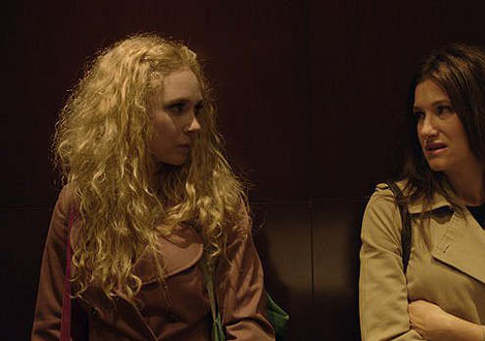
JUNO TEMPLE AND KATHRYN HAHN IN AFTERNOON DELIGHT
Jill Soloway: Afternoon Delight (2012)
Not-quite-dolce far niente
"How dare any of us? Rachel, do I need to remind you how much time you spend giving back?" queries Rachel's complacent, stylishly bespectacled lady shrink Lenore (Jane Lynch, droll), after the too-idle Rahcel's dissed her own complaining given the woes of the women of Darfur. It's a signal moment in this somewhat lazy and self-indulgent study of a well-off suburban LA matron who hasn't enough to do, besides preschool auctions, lackluster sex, and a kaput career, and fills the void by the very unwise choice of trying to save a stripper. Soloway, who has worked much in TV, writes specific, sometimes funny dialogue (for the women in the film anyway), but has an uncertain sense of tone here, wavering from the naturalistic to the comical to, at the last minute, some serious drama. Mostly this is a sit-com with touches of vérité; it promises something more, but due both to undue absorption in its clued-in social delineations and lack of a strong plotline, it never delivers. Soloway's observant specificity ultimately comes across as chattering trivia. Come to think of it, that describes a lot of American TV. But not all TV, anyway, since in this case Soloway has managed to make a film full of contemporary mom talk whose explicit sex would be uncomfortable or distasteful for most moms.
The chatty, people-pleasing, annoyingly motor-mouthed Rachel is played by Kathryn Hahn (of Parks and Recreation, Crossing Jordan). Her husband Jeff (Josh Radnor, fine) is apps-rich; they have a small boy, Mason (Noah Kaye Bentley). Rachel is active aat the Jewish Community Center -- perhaps she's a repressed or hideously deformed version of an old-fashioned Jewish mother -- till all this happens: to liven up their sex life, or just out of desperate boredom on Rachel's part, Rachel and Jeff and another couple go to a strip club, where Rachel gets a private session from confident little blonde "sex worker" (as she later styles herself) 19-year-old (she says) McKenna (Juno Temple, convincing). After this even the still desperately bored Rachel starts stalking McKenna across from the strip club, meets up and chats with her a couple of times -- and when she finds her deprived of her car and a place to live, takes her home, later even takes her in as a nanny for her kid. Jeff disapproves, but perhaps likes having McKenna to ogle. Rachel decides to "save" McKenna (get this) by providing her with a blog, to "tell her story." All this, lo and behold, does revive Jeff and Rachel's sex life. But then sex invades their and Rachel's girlfriends' and fellow moms' lives via McKenna more than they'd planned for. Yet eventually Soloway settles for the unlikely fantasy that seriously messing up can renew a marriage and even a life.
This is the kind of little movie that may have enough to make it distinctive but not quite enough to make it memorable. It isn't a surprise that the secondary female characters are drawn more distinctly than the male ones. But this remains a women's picture that women won't much want to watch; Hahn is surprisingly annoying for a protagonist, by the way. Audience-focus problems.
Afternoon Delight, 99 mins., debuted at Sundance 2013, was also shown at the SFIFF. Reviewed as part of the San Francisco Jewish Film Festival. Limited US theatrical release 27 August 2013.
Last edited by Chris Knipp; 01-02-2015 at 08:09 PM.
-
Hilla Medalia: DANCING IN JAFFA (2013)
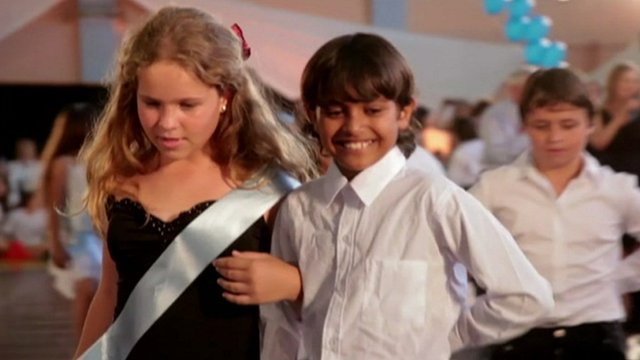
LOIS AND ALAA
Hilla Medalia: Dancing in Jaffa (2013)
Bringing together "enemies" in dance
Hilla Medalia is an award-winning 36-year-old Israeli documentary filmmaker whose 2007 To Die in Jerusalem brought together in dialogue (by satellite) the mothers of two teenage girls paired on a Newsweek cover, a Palestinian suicide bomber and an Israeli girl killed by her bomb. Her new film is about a less grim effort by famous ballroom teacher Pierre Dulaine to bring Jewish and Palestinian kids together on the dance floor, and we see some little friendships and personalities bloom in his modest "peace process."
Jaffa, once a Palestinian town, is now a poor, mixed suburb of Tel Aviv. The intense 2009 joint Israeli- Arab feature film Ajami focused on a rough part of Jaffa. In Dancing in Jaffa, Hilla Medalia follows Pierre Dulaine as he goes back to Jaffa, where he was born in 1944, son of an Irish father and Palestinian mother. (In the film he never mentions that his mother was also half French, which explains "Pierre.") He has not been back since his family was driven out when he was a child. He comes to introduce to Palestinian-Israeli, Jewish-Israeli, and mixed schools in Jaffa his Dancing Classrooms, a social development program for fifth-graders that uses ballroom dancing "as a vehicle to change the lives of the children and their families" (Wikipedia). This time the primary "change" is the somewhat radical one of pairing Jewish and Arab girls and boys as dance partners.
In teaching gawky eleven-year-olds to dance, the pixieish Dulaine emphasizes etiquette, dignity, and respect from the get-go. He has to give up on one school because they boys won't dance. The more extreme muslim males won't touch girls, or at first refuse. Things don't go that well at first, and for a while Pierre brings over from the States his (dancing, not life) partner of 35 years, Yvonne Marceau. Their dancing together for the kids inspires them: you can see the boys' eyes light up; they are charmed.
Medalia follows several of the kids more closely, notably Noor, a plump, dark Palestinian girl whose grief over the death of her father makes her sullen, depressed, and sometimes violent. Alaa is a small boy who lives in a shack with his poor fisherman father. Alaa, dark and all smiles, and Lois, a curly-haired Jewish girl fathered out of a sperm bank, become partners for the upcoming dance contest, and their jaunt on Alaa's father's little rowboat heralds a budding friendship. But the real miracle is Noor, who shows rhythm and grace from the start, and whose selection for the competition is part of a reawakening and new happiness that you can't help being a little amazed by. Ah, fifth graders: this is the age when kids are most open and malleable.
The film shows other things, like Dulaine approaching his family's original residence and beating a hasty retreat when the current occupants are not just unfriendly but apparently downright hostile. Dulaine mostly speaks English, but he also speaks Arabic to the kids who understand Arabic. For Hebrew, he has an interpreter or the teachers translate for him. The schools he visits are Israeli-Palestinian, Israeli-Jewish, and mixed Palestinian-Jewish. There are seven different dances in the lessons and final contest, though merengue and rumba seem to predominate. At the final contest, all the parents are as excited as you'd expect. Each dance couple pairs a Palestinian and a Jew. And nobody seems to mind. At least for the moment, Dulaine has achieved reconciliation and crossed barriers that earlier seemed uncrossable.
All this will be vaguely familiar, because you've probably seen a couple of other movies Pierre Dulaine inspired, the 2006 musical drama Take the Lead, starring Antonio Banderas as Dulaine, and Mad Hot Ballroom, a heartwarming and popular 2005 documentary about New York fifth graders who learn dance and take part in a dance contest. However, Dancing in Jaffa prefers not to mention these, and alludes only vaguely to Pierre Dulaine's fame as a ballroom dancer when he partnered with Yvonne Marceau at Jacob's Pillow, on Broadway, and in London, or his having been on the faculties of the School of American Ballet, Alvin Ailey American Dance Theater, and the Juilliard School. This movie isn't about that. It's about little Jewish and Palestinian Israeli kids being polite and friendly and wiggling their hips gracefully together. Dancing in Jaffa, a fairly simple and minimal film, isn't as priceless and cute or as proficiently made as Mad Hot Ballroom. But the gaps it bridges are, of course, more significant.
Dancing in Jaffa, 84 mins., in Arabic, English, and Hebrew with English subtitles debuted in NYC in January 2013, and was included in the Tribeca and Sydney festivals. It has been picked up by Sundance Selects. Screened for this review as part of the San Francisco Jewish Film Festival (July 26-Aug. 10, 2013). The film is set for limited US release April 11, 2014.
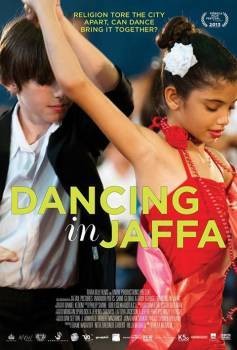
Last edited by Chris Knipp; 01-02-2015 at 08:11 PM.
-
Yotam Feldman: THE LAB (2012)
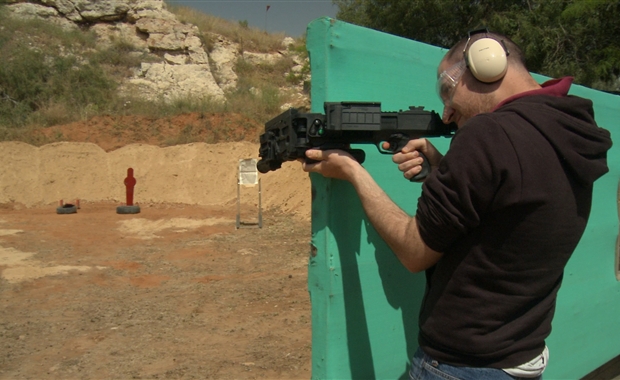
THE LAB SHOWS WEAPON THAT SHOOTS AROUND CORNERS
Yotam Feldman: The Lab
Gaza and the West Bank are used as testing grounds for new weaponry by arms manufacturers, dealers, and exporters, and if you don't believe that, you need to watch this documentary. This is one of those films where people proudly talk about activities they may be unaware the viewers will find horrific and disgusting. Like the makers of recent films about Israeli judges ( Ra'anan Alexandrowicz,'s The Law in These Parts, SFIFF 2012) and Israeli security/intelligence (Dror Moreh's The Gatekeepers, NYFF 2012), Yotam Feldman provides an exposé of truths about Israel in which, beginning as an investigative reporter, he has gained unusual access to the powerful people he studies, and with detachment and sometimes humor or irony presents a deeply revealing picture.
By the way, Israel is the fourth largest weapons manufacturer and exporter in the world, so that makes this a doubly important study. Feldman's message is that the Israeli economy (public and private) has become highly dependent on the country's massive and flourishing "security" market. Reps of other governments are hypocritical, some Israeli spokesmen point out, when they knowingly purchase Israeli arms tested out in use against Palestinians, and yet go on to criticize Israeli violence.
One thing that is especially chilling is that foreign visiting potential purchasers are most interested in the testing of the Israeli weapons, including new ones like a gun that shoots around corners, which are used, often, on Palestinians, or on their land; above all, for urban warfare. And the industry directly feeds off the Israeli military. Retired officers become arms dealers; the minister of defense becomes the minister of industry. Feldman says everyone remarks on the Israeli economic miracle, "growth and prosperity despite military confrontations. But maybe it's not despite them, it's because of them." Israeli arms dealers, military men, and "defense consultants" point out the hypocrisy of people in other countries who criticize the Israelis for their brutality in assaults like Operation Cast Lead, the battering of Gaza in which 11 Israelis died and 1,200 Palestinians -- a lab for Israeli weaponry -- but then come to Israel to profit from the experience and the "testing."
Since the world's military get orientation and arms arms from Israel, Israeli influence will lead and is leading to reproducing similar Palestines in many other countries, Feldman suggests. He accompanies the big, jovial, magnanimous and grandfatherly (and military man) Leo Gleser on a business trip to Brazil, one of the Israel defense industry's biggest clients, and finds that the inhabitants of the drug-dealer-dominated Rio favelas are indeed the Brazilians' Palestinians. In recent years the Brazilian police took over the Rio slums, using Israeli-style military methods and Israeli weapons. They even nicknamed one Rio slum district they took over from the drug dealers "the Gaza strip."
Like The Law in These Parts and The Gatekeepers, The Lab also is essential viewing for the information it provides about Israel.
Length: 57 mins. Original title: Hamaabada . Israel/Franch/Belgium production, in Hebrew. Debuted 24 April 2013 at the Visions du Réel Film Festival. Released in Israel, reportedly destined for release in other countries. Screened for this review as part of the 2013 San Francisco Jewish Film Festival.
Last edited by Chris Knipp; 01-02-2015 at 08:13 PM.
-
Clara Kuperberg, Joelle Oosterlinck : THE ART OF SPIEGELMAN (2010)
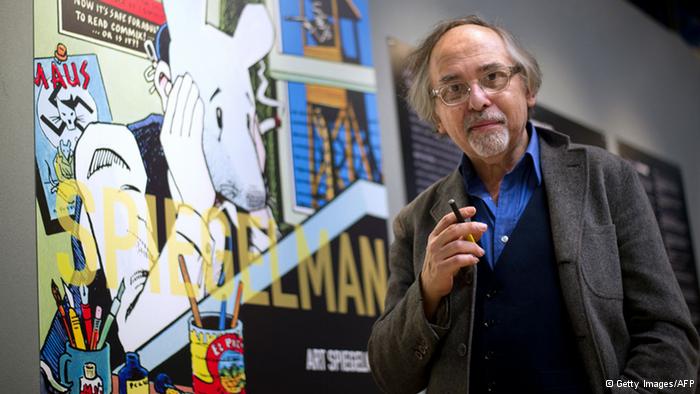
ART SPIEGELMAN
Clara Kuperberg, Joelle Oosterlinck : The Art of Spiegelman (2010)
This short biopic is the self-narrated story in brief of the renowned American "underground comix" cartoonist best known for his graphic novel Maus (1986, 1991). To insiders or counterculture hipsters his work as co-editor on the comics magazines Arcade and Raw is important. Besides that he spent a decade as contributing artist for The New Yorker starting in 1992, where he made several high-profile and sometimes controversial covers. He is married to the French-born artist, designer and editor and longtime collaborator Françoise Mouly, who has also incidentally been the art director of The New Yorker since 1993. Spiegelman talks to the camera. His wife talks to the camera too, more briefly, speaking in French though when she says an English word or name her accent is perfect.
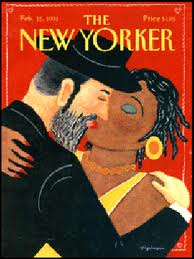
CONTROVERSIAL
1993 NYER COVER
Spiegelman's Maus, which took 13 years to complete, is a graphic novel based on conversations with his father, a Polish Holocaust survivor. Art was born in Sweden, and then they came to the US. Maus depicts the Holocaust experience metaphorically, through animals. The Jews are mice. The ethnic Poles are pigs. The Nazis are cats. This got Spiegelman a Pulitzer. But it seems to have been a hard act for him to follow; he had a dry period after its success, suffered even from that success. September 11, which the Spiegemans experienced directly (one of their children was at a school nearby) fed him creatively: he says that trauma inspires him. Spiegelman is a quick intellect who knows his own mind and speaks articulately, exuding intelligence and joie de vivre. This film is a pleasure to watch. They live somewhere in Soho in NYC, and the views of the old urban landscape are beautiful. Gives a feeling of what fun it would have been to live in lower Manhattan in the good old days and do well enough to survive there comfortably even today (if you can find a grocery store among the Prada and Ralph Lauren stores). This is by the prolific French team of short documentary filmmakers of Clara Kuperberg and Joelle Oosterlinck, which explains Françoise Mouly's addressing the camera in French. The many shots of Spiegelman and his family in and around their SoHo digs in Lower Manhattan bespeak a convivial, arguably enviable, life at the center of East Coast literary-artistic culture, and however much Art may need suffering and trauma as his inspirations, his narration and demeanor suggest a happy and articulate man.
Length: 40 mins. Original title: Art Spiegelman, Traits de mémoire, shown on French TV 2012; debut in the New York Jewish Film Festival in January 2013.
Last edited by Chris Knipp; 01-02-2015 at 08:17 PM.
-
Rachel Loube: EVERY TUESDAY, A PORTRAIT OF THE NEW YORKER CARTOONISTS (2011)
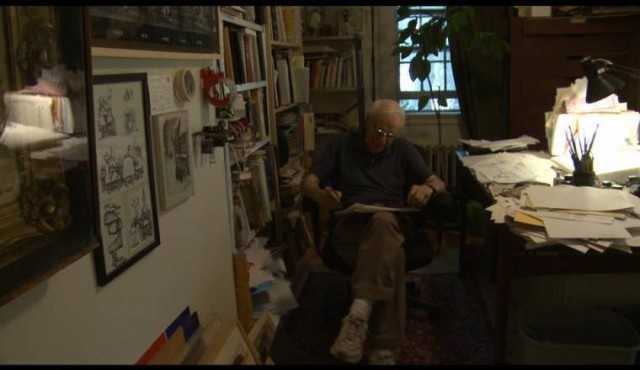
Longtime New Yorker cartoonist Sidney Harris, whose cartoons, drawn with classic
pen and ink, usually refer to science or math
Rachel Loube: Every Tuesday: A Portrait of the New Yorker Cartoonists (2011)
This shorter film from the School of Visual Arts in New York provides a kind of companion piece to The Art of Spiegelman. The link is The New Yorker magazine, on which Spiegelman's wife is Art Director, for which he did many covers over several decades. Here, we glimpse a whole group of people who draw the magazine's famous cartoons. Every Tuesday the next week's cartoons are chosen, and the main cartoonists, who vie with each other for the few spaces in each issue, get together at a restaurant for lunch. If what New Yorker cartoons are like (now anyway) and how they are chosen, you might also like to watch another short film of similar length, not in the Jewish Film Festival but available as a YouTube video, Bob Mankoff: Anatomy of a New Yorker Cartoon. Mankoff is the cartoon editor, also one of the magazine's more successful cartoonist of recent years. There is nothing in either of these 20-minute films about the great New Yorker cartoonists of the past (whose cartoons I grew up with), the most famous being Charles Addams, Peter Arno, Charles Barsotti, George Booth, Roz Chast, Tom Cheney, Sam Cobean, Leo Cullum, Richard Decker, Helen E. Hokinson, Ed Koren, Mary Petty, George Price, Charles Saxon, David Snell, Otto Soglow, Saul Steinberg, William Steig, Richard Taylor, James Thurber, Pete Holmes, Barney Tobey and Gahan Wilson. Addams, Arno, Steinberg, and Thurber were household words in ways no ones since have been.
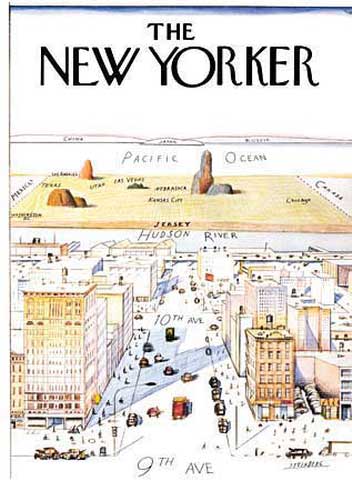
Steinberg's famous cover showing nothing between the
Hudson River and the Pacific
It feels to a lot of lifetime New Yorker readers who go back a while (and my mother read it when it began, and I read it as a child of the Forties and Fifties) that the editorial reign of the buzz-hungry English shock-journalist Tina Brown that began in 1992 is one from which the magazine will never recover; that David Remnick is a continuation of Tina Brown, and things went downhill after Harold Ross (1925-52) , William Shawn (1952-87) and the brief editorship of Robert Gottleib (1987-92), more known as a book editor at Knopf (he discovered and edited Catch-22) If you peruse the New Yorker's own "Timeline," you can follow the comings and goings of some of the great writers and artists associated with this American cultural monument. It's arguable that the promotional events, cruises, and special issues begun by Tina Brown to advertise and grandize the magazine have diluted its original independent flavor. However, a New Yorker cartoon is still something special even with Charles Addams, Peter Arno, and James Thurber long gone.

Every Tuesday shows ten cartoonists lunching together but interviews four, Sidney Harris, Emily Flake, Drew Dernavich, and Zach Kanin – they provide a sketchy but quite varied picture of the range of personalities and styles making the magazine's cartoons. Mankoff's talk will give you more of a sense of the selection process.
Leah Wolchok and Davina Pardo are raising funds to complete a historical documentary about New Yorker cartoonists. The subject so far has only been touched on, though the peripherally related Art of Spiegelman short doc is highly recommended as an introduction to his life and work.
Every Tuesday: A Portrait of the New Yorker Cartoonists, 22 mins., was screened for this review as part of the 2013 San Francisco Jewish Film Festival.
Last edited by Chris Knipp; 05-06-2015 at 07:23 PM.
-
Martha Shane, Lana Wilson: AFTER TILLER (2013)
Martha Shane and Lana Wilson: AFTER TILLER (2013)
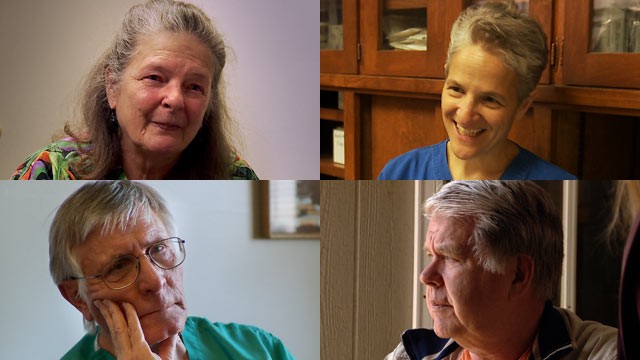
ROBINSON AND SELLA, ABOVE; HERN AND CARHART, BELOW
Late term abortion: a world of impossible choices
Abortion is controversial; late term abortion, because the fetus is more developed and may be viable, is more so. This is a documentary about the four constantly tormented physicians in the US who continue to perform late-term third trimester abortions (after the twentieth week of pregnancy), in the wake of the 2009 assassination in Wichita, Kansas of Dr. George Tiller. They are Dr. Susan Robinson and Dr. Shelley Sella, who perform abortions at a clinic in Albuquerque, New Mexica; Dr. Warren Hern, the Director of the Boulder Abortion Clinic in Boulder, Colorado; and Dr. LeRoy Carhart, with an abortion clinic in Bellevue, Nebraska, who has begun running a clinic in Maryland since a law in Nebraska has prevented late term abortions there. All of these doctors worked with, and are inspired by, Dr. Tiller.
This film is good at showing the four doctors' lives, outlooks, and their and their counselors' conferences with patients and considering of their decisions. It considers some pro-life arguments, such as that fetuses feel pain (the Obstetrics and gynaecology community says no), but it does not go into the abortion procedures in detail, nor into the differences in state laws, or the situation of abortion in the rest of the globe. These omissions are understandable, because the procedures are painful to consider and variations in laws in the US and worldwide are tangled and confusing. From the bioethics viewpoint, this film nonetheless provides some good material, except that it does not consider the anti-abortion position in any detail, except insofar as in each case considered the doctors and the patients would rather not have an abortion if it did not seem imperative. Note that: late-term abortions account for only 1% of abortions performed; most of them are to terminate planned pregnancies when the mothers have discovered their baby is seriously malformed or ill and will live only a short life of pain, if delivered.
This film shows that "pro-life," anti-abortion activists are always picketing the clinics where the doctors practice. In particular it shows how they sought to prevent Dr. Carhart from coming to Maryland. And though the laws in Maryland were most beneficial to Carhart, it was difficult for him to find anyone who would rent to him. Todd Stave, the owner who rented to him, actually became more resolved to do so after anti-abortionists resorted to picketing the school his son attended. Satve's father performed abortions and was victimized by opponents. These doctors are all fighting back against the anti-abortion camp, refusing to be intimidated, knowing that they may meet Dr. Tiller's fate, but preferring to do what they think right rather than back down. They are getting older --- in fact Dr. Tiller was sixty-seven, but, though Dr. Hern takes more time off to spend with his sedond wife and her son (he has married recently), they can't retire, because there is no one to replace them. This is controversial work. It's war. Tiller was shot as he attended church. The pro-life camp doesn't play fair. Killing people or humiliating the child of a man who rents to an abortion doctor is abhorrent.
Shane and Wilson deftly provide just enough details about the lives and personalities of the doctors to make them three-dimensional. Dr. Carhart's wife, with whom he says he's been together since they were twelve, manages the clinic. They also raise and board horses. When back in the eighties a fire killed a lot of their horses and anti-abortionists said it was justified punishment for killing babies, that strengthened his wife's determination to be involved in the work. There is less about Dr. Susan Robinson, but there is more footage of her in her clinic with patients and her counselors considering individual cases. She says that the only reason she can say no ultimately is that the procedure would not be safe for the patient. These four doctors are all unusually tough and compassionate.
This film doesn't clarify for me what stand to take about abortion in general, or all the arguments pro or con. There aren't any easy choices here. This is one of the knottiest issues, and late-term abortion is the toughest kind of abortion to consider. A look at these doctors was worthwhile. Alissa Simon of Variety concludes this debuting documentary pair "manage a rare feat in After Tiller, making a calm, humanist docu about a hot-button topic." This is indeed tough material dealt with calmly and quietly.
After Tiller, 88 mins., debuted at Sundance January 2013. It is being released by the young maverick distributor Oscilloscope. The US theatrical release will begin in NYC Sept. 20, 2013 (Film Forum and the Film Society of Lincoln center Elinor Bunin Theater). Screened for this review as part of the SFIFF.
Last edited by Chris Knipp; 01-02-2015 at 08:27 PM.
 Posting Permissions
Posting Permissions
- You may not post new threads
- You may not post replies
- You may not post attachments
- You may not edit your posts
-
Forum Rules





 Reply With Quote
Reply With Quote










Bookmarks